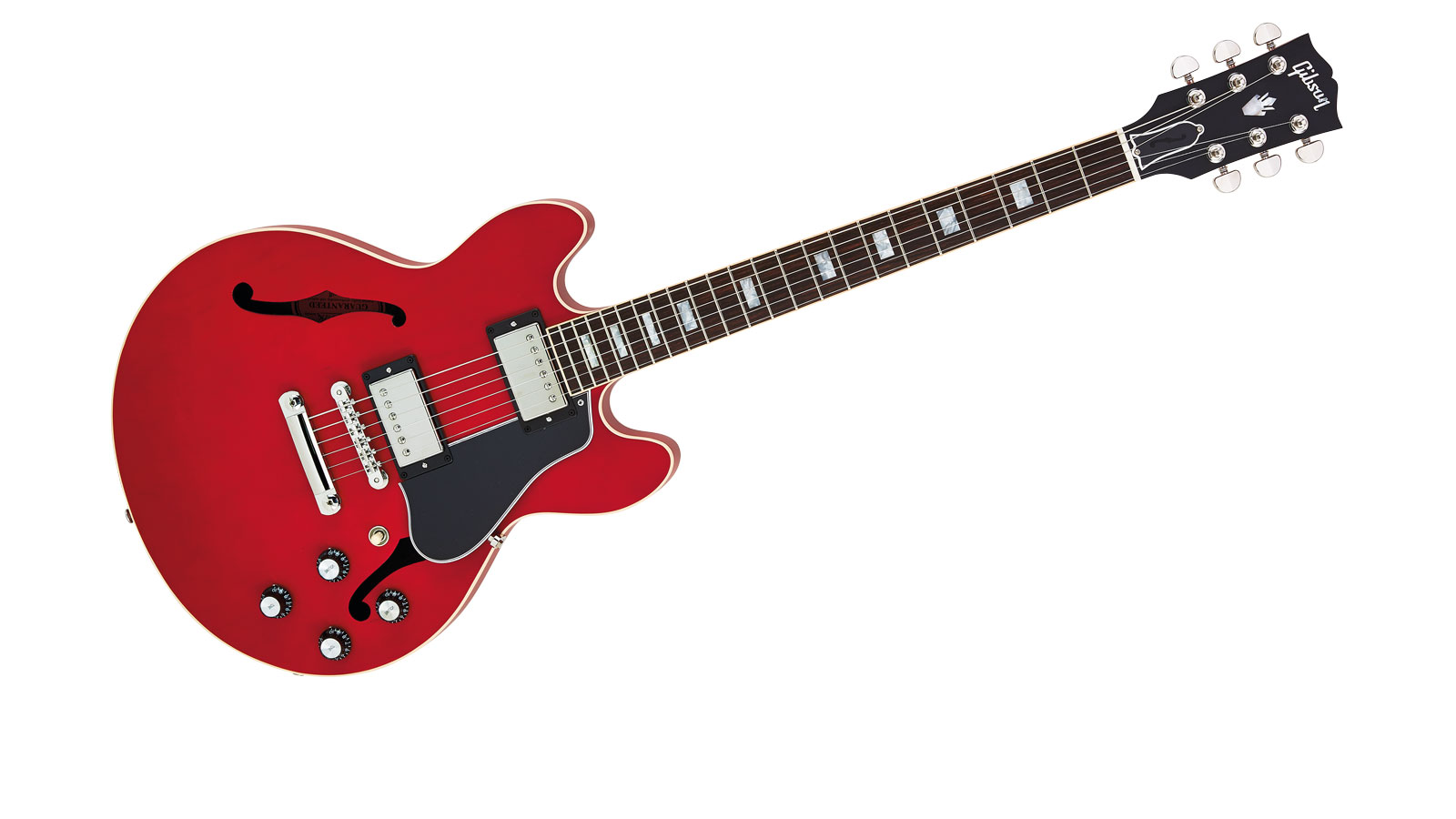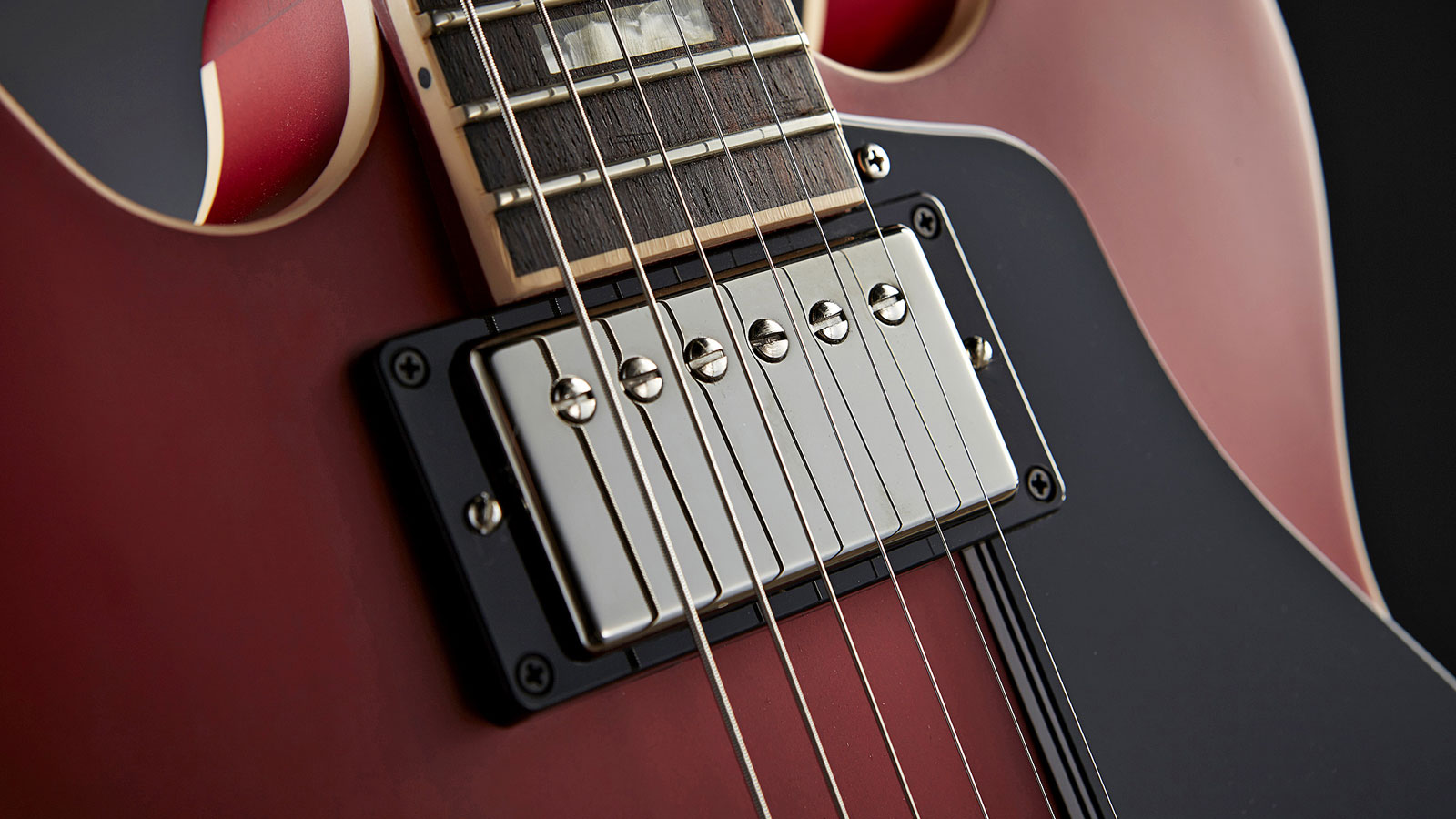MusicRadar Verdict
Compact dimensions with classic tones and styling; if you want the ES-335 experience in a smaller package, then this is it.
Pros
- +
A fine balance of traditional styling and modern playability. Burstbuckers sound the part.
Cons
- -
We recommend you try a couple before you buy. A few very minor finish issues.
MusicRadar's got your back

Gibson Memphis ES-339 Satin 2015

Neck pickup
While internet forums still smoulder in response to the sweeping changes that Gibson rolled out across its Nashville-made USA line for 2015, a couple of hundred miles west on the I-40, under the watchful eye of Mike Voltz, Gibson's Memphis facility continues its own, quieter evolution. Fresh of the line in 2015 is this satin-finished ES-339 semi.
Build
The ES-339 Satin takes its styling cues from the block-inlay ES-335 introduced in mid-1962 but incorporate a range of upgrades with the modern player in mind.
You'll find no zero fret brass nuts or faux-handwritten headstock logos here. Although Gibson Memphis has equipped this instrument with an f-hole logo'd truss rod cover for the 2015 model year - a logo that doesn't appear on more period-specific vintage reissues - it's a subtle motif that's barely visible from a distance.
"As ever, we'd always suggest playing a bunch of these guitars in the flesh and buying the one that you like the best"
This trend continues throughout a range of thoughtful updates, starting at the bridge. The traditional Gibson Tune-o-matic bridge and stud tailpiece arrangement has always been worryingly mobile when not held under tension during string changes, so the decision to replace this with a locking tailpiece and TonePros AVR-II bridge gets our vote.
Not only do the new parts look vintage-authentic enough from afar to appease traditionalists, aside from the practical benefits of having your optimal setup locked down (less rattle, less tweaking required after string changes), there's also more travel on the AVR- II's saddles, allowing for more adjustment range should you need it.
Towards the other end of the strings, a bone nut offers improved durability over synthetic options and some will even profess to hear tonal differences, too. It's certainly true that the guitar exhibits less of the almost banjo-like 'plunkiness' that characterises the acoustic tonality of even the finest vintage ES-335s.
Other specification updates include new, old-style Grover 'Milk Bottle' Rotomatic tuners, lightly-rolled neck binding, lower-profile frets, a Historic truss rod that boasts "superior adjustability" thanks to its Teflon coating, larger rod diameter, original brass anchor and larger washer, and a thicker peghead transition, which should be both more stable and provide more resistance to the dreaded headstock break.
Want all the hottest music and gear news, reviews, deals, features and more, direct to your inbox? Sign up here.
The instrument is finished in a satin cherry-coloured lacquer - the official spec describes the ES-339's finish as 'Cherry' - which is visually very one-dimensional, to the extent that the top of the guitar almost appears to be flat rather than arched.
Though the finish will burnish in certain contact areas over time, the temptation to give this guitar the T-Cut treatment in order to give it more of a vintage-style VOS look is considerable, and it would be entirely in keeping with the early-60s aesthetic.
The ES-339's output jack is located in a position that will be more familiar to Les Paul players but electronically, and indeed in the case of most of its spec - smaller body aside - it's otherwise identical to it's sister model Memphis ES-335 Satin.
Gibson has opted for a medium-output Burstbucker 1 (neck) and Burstbucker 2 (bridge) pickup with Alnico II magnets and unmatched bobbin windings in pursuit of the high-end detail offered by the better vintage PAF humbuckers.
In addition, while a fairly standard 0.022uF capacitor is retained for the bridge pickup, the neck pickup's tone control uses a 0.015uF that, in theory, should mean slightly less of the highs are cut as the control is reduced.
Mind you, the +/- 20 per cent tolerance rating of the 500k CTS pots means that any of the pots could be between 400 and 600k in practice, which could certainly have tonal consequences: one guitar may sound noticeably brighter or darker than the next so, as ever, we'd always suggest playing a bunch of these guitars in the flesh and buying the one that you like the best.
Feel & Sounds
Compared to our 2015 ES-335, the ES-339 has a slightly more rounded neck shape that's 0.76mm deeper at the 1st and 12th frets.
The effect of the light rolling to the fingerboard edges is subtle but pleasing, helping the guitar have a comfortable familiarity that allows you to concentrate on the important matter at hand: making music.
"It is a sensitively updated, excellent-sounding and highly playable take on one of the most versatile electric guitar designs ever conceived"
The fretwork and binding on both guitars is neat and smooth - it's not laser-precise and there are a few stray file marks on the higher reaches of the fingerboards, but there's no aspect of either guitar's finishing that would deter us from parting with our readies.
'57 Classics were long the pickup of choice on modern Gibson semis, and while they are by no means bad-sounding units, we're much more impressed by the Burstbuckers here; in general, there's much more air and clarity in the treble frequencies, which translates into the most expressive, musical-sounding cleans we've heard from new humbucker-loaded Gibson thinlines outside of the ranks of the Historic models.
The capacitor changes may seem subtle but we definitely hear a more svelte and less syrupy 'woman' tone when you roll either tone control back and add gain, too.
In a direct A/B comparison with an ES-335, the results are almost exactly as we'd expect: the ES-339's smaller proportions make it a little more direct, perhaps a touch louder and certainly punchier in the midrange; it's a step closer to a Les Paul compared with the airier, slightly more scooped voice of the ES-335.
This writer has always found the proportions, strapped-on balance and upper-fret access of an ES-335 to be just about perfect, but we concede that there are many players - either due to physical stature or a greater familiarity with more compact solidbody designs - for whom wielding a big semi is a daunting proposition.
It's certainly true that the more delicately proportioned ES-339 attracted more attention than its bigger sibling during its stay in the office and with good reason - it's a very good guitar indeed.
If we acknowledge that it's not the size of your semi that counts, it's what you do with it, ahem, then the bottom line is that there isn't a lot that you can't do with this instrument.
It is a sensitively updated, excellent-sounding and highly playable take on one of the most versatile electric guitar designs ever conceived, providing further proof that while the activity in Gibson's Nashville factory continues to dominate the headlines, the Memphis arm of the company is carrying on quietly with the business of making wonderful electric guitars for touring professionals and discerning amateurs alike.
Dave Burrluck is one of the world’s most experienced guitar journalists, who started writing back in the '80s for International Musician and Recording World, co-founded The Guitar Magazine and has been the Gear Reviews Editor of Guitarist magazine for the past two decades. Along the way, Dave has been the sole author of The PRS Guitar Book and The Player's Guide to Guitar Maintenance as well as contributing to numerous other books on the electric guitar. Dave is an active gigging and recording musician and still finds time to make, repair and mod guitars, not least for Guitarist’s The Mod Squad.
